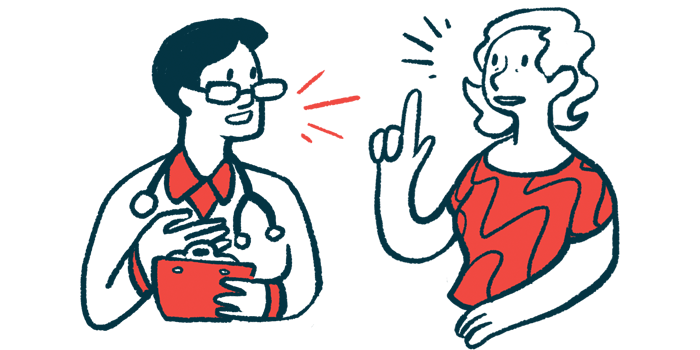Long-term Isturisa Lessens Cushing’s Physical Features, Trial Data Show

Nearly 1.5 years of treatment with Isturisa (osilodrostat) rapidly and sustainably eased — and in many cases completely eliminated — disease-associated physical features in people with Cushing’s disease, according to data from the Phase 3 LINC 3 trial.
Improvements were noted from early on, consistent with the previously reported rapid and sustained reduction in cortisol levels, whose excess causes Cushing’s and its symptoms.
“Changes to physical features caused by Cushing’s disease can have a significant impact on patient health and well-being,” Mohamed Ladha, president and general manager of North American business at Recordati Rare Disease, which markets the therapy, said in a press release. The company acquired global rights to Isturisa from Novartis, its initial developer, in 2019.
“The data further confirm that ISTURISA is an effective treatment for patients with Cushing’s disease,” and Recordati “strives to improve the lives of patients with this rare, debilitating and potentially life-threatening condition,” Ladha added.
These findings, along with additional positive results from LINC 3, were shared by Alberto Pedroncelli, MD, PhD, Recordati’s head of clinical development and medical affairs-endocrinology, through an oral presentation and a poster at the 2022 American Association of Clinical Endocrinology annual meeting, held May 12–14 in San Diego.
In Cushing’s disease, a tumor in the brain’s pituitary gland causes the body to overly produce the hormone cortisol.
Isturisa is an oral therapy that works by suppressing 11-beta-hydroxylase, an enzyme involved in cortisol production. As such, it is expected to lower, or even normalize, cortisol levels and subsequently ease Cushing’s wide variety of physical, hormonal, and psychological symptoms.
It is approved in the U.S. to treat adults with Cushing’s disease for whom pituitary surgery was ineffective or not feasible. It’s also approved in Europe, Switzerland, and Japan for endogenous Cushing’s syndrome.
These approvals were mainly based on top-line results from the Novartis-funded, Phase 3 LINC 3 trial (NCT02180217), which showed that Isturisa was superior to a placebo at keeping urinary cortisol levels within a normal range in adult Cushing’s patients.
The study enrolled 137 adults (106 women and 31 men) with persistent or recurrent Cushing’s disease, classified as having urinary cortisol levels measuring more than 1.5 times the normal upper limit. Their median age was 40 (range, 19–70 years).
During LINC 3’s 48-week core portion, most patients continuously received the therapy, while about a quarter were switched to a placebo for a period of eight weeks, after which they resumed treatment.
After completing the trial’s core phase, 106 participants chose to enter its extension phase, in which they received Isturisa until all had completed at least 72 weeks (nearly 1.5 years) of treatment.
In the oral presentation “Osilodrostat therapy improves physical features associated with hypercortisolism in patients with Cushing’s disease: Findings from the Phase III LINC 3 study,” Pedroncelli described LINC 3’s 72-week data in terms of changes in Cushing’s physical features.
Evaluated features included fat accumulation around the torso (central obesity), above the collarbone (supraclavicular fat pad), or between the shoulders (dorsal fat pad), facial flushing, excessive body hair (women only), atrophy in the muscles closer to the torso, bruises, and pink or purple stretch marks.
At the study’s start, most patients showed physical manifestations of excess cortisol, most commonly central obesity and supraclavicular and dorsal fat pads. Central obesity was also the most frequent feature rated as severe by investigators.
The proportion of patients showing improvements, or reduced severity, in physical features from study’s start was generally increased from week 12 to week 72. Supraclavicular and dorsal fat pads, as well as facial flushing, were the features most often deemed as reduced throughout the study.
Between weeks 48 and 72, there was a slight reduction in the proportion of patients showing lower severity in central obesity, proximal muscle atrophy, bruises, and stretch marks.
Few physical manifestations were rated as worsening over time, including excessive body hair in female patients, and by week 72 most physical features were rated as absent in more than half of the patients. The exception was central obesity, which was most commonly rated as mild (36.5% of patients) and absent in only 30.6% of patients.
Also, there was an overall trend for reductions in mean body weight, body mass index (a ratio of weight to height), and waist circumference.
“Improvements in physical manifestations associated with hypercortisolism [excess cortisol] were observed soon after initiation of [Isturisa] and were sustained throughout the study,” the researchers wrote.
In the poster, “Hypertension and Diabetes Improvement During Osilodrostat Therapy in Patients with Cushing’s Disease: Analyses from the Phase III LINC 3 Study,” Pedroncelli presented 48-week data related to high blood pressure (hypertension) and diabetes, two common complications of Cushing’s.
At the beginning of LINC 3, 87% of patients had hypertension, and 45% were diabetic.
Isturisa treatment was associated with a reduction in both mean blood pressure and mean fasting blood sugar levels, and at least half of these patients saw their values normalize at some point in the study.
In addition, 40% of patients taking antihypertensive medication and 49% of those on antidiabetic medication at the study’s start stopped or reduced their dose by week 48 (nearly one year). In turn, increases in the dose or number of medications were reported in 40% of hypertensive patients and 23% of those with diabetes taking such therapies.
Notably, changes in blood pressure and blood sugar levels were not significantly associated with changes in urinary cortisol levels over time.
These findings highlight that Isturisa “is effective at improving clinical signs and may alleviate hypercortisolism-associated treatment burden, which could benefit some [Cushing’s patients],” the researchers wrote.
“Close follow-up is needed as [simultaneous] medication adjustments are required in some [patients], including those with improvements in [hypertension or diabetes],” they wrote.







